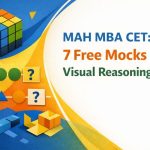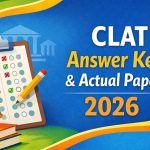The MAH MBA CET 2026 is a reasoning-heavy, computer-based entrance test used by 300+ management institutes across Maharashtra. The syllabus covers four main sections: Logical Reasoning, Abstract Reasoning, Quantitative Aptitude, and Verbal Ability & Reading Comprehension (VARC), comprising 200 MCQs to be solved in 150 minutes, with no negative marking.
Section wise Syllabus Overview
| Section | No. of Questions | Weightage (%) | Level/Trends |
| Logical Reasoning | 75 | 38 | Most dominant; high complexity in seating, puzzles, arrangements |
| Abstract Reasoning | 25 | 12 | Visual, non-verbal logic; moderate, predictable |
| Quantitative Aptitude | 50 | 25 | Arithmetic-heavy; moderate difficulty |
| Verbal & RC | 50 | 25 | RC-heavy; moderate vocabulary/grammar |
Logical Reasoning: Chapters, Weightage & Trends
Key Chapters & Average Distribution
- Seating Arrangement & Puzzles (Linear, Circular, Matrix): 25-30 Qs
- Coding-Decoding (All types): 10-12 Qs
- Syllogisms & Logical Deductions: 7-10 Qs
- Series (Number, Letter): 7-10 Qs
- Blood Relations: 7-8 Qs
- Critical Reasoning (Statement-Assumption, Cause-Effect, Inference): 4-8 Qs
- Miscellaneous: Venn Diagrams, Directions, Clocks, Odd One Out, Input-Output, Data Sufficiency: 6-10 Qs
Logical Reasoning Section: Chapterwise Weightage (Approximate)
Chapterwise Distribution Table
| Topic | Estimated Qs (range) | Weightage (%) |
| Seating/Puzzles | 25–30 | 35 |
| Coding-Decoding | 10–12 | 15 |
| Syllogisms | 7–10 | 10 |
| Series | 7–10 | 10 |
| Blood Relations | 7–8 | 10 |
| Critical Reasoning | 4–8 | 7 |
| Other Reasoning | 6–10 | 13 |
Notable Trends & Changes (Last 3 Years)
- Slight shifts in number of questions per slot, but total LR 75 always.
- From 2025, all slots standardized for fair comparison; earlier slot variability existed.
- Enhanced focus on multi-layered puzzles and complex arrangements.
- Blood relations, coding-decoding continue as stable, high-impact topics.
- Rising presence of logical deduction and critical reasoning.
Scoring Strategy
- Prioritize seating arrangements and puzzles: consistent high-weightage and require practice.
- Strong familiarity with coding/decoding and series can maximize attempts.
- If weak in critical reasoning, attempt easier sets and move on—time management is key.
Abstract Reasoning: Chapters & Emphasis
Key Topics
- Figure-based Series, Analogy, Odd-One-Out
- Pattern Completion, Mirror and Water Images, Paper Folding/Cutting
- Symbol-based Logic, Matrix Reasoning
- Classification, Sequencing
Average Chapterwise Breakdown
| Subtopic | Typical Qs | Weightage (%) |
| Series/Analogy | 10 | 40 |
| Pattern Matching | 5 | 20 |
| Image Analysis | 5 | 20 |
| Miscellaneous | 5 | 20 |
- All questions are non-verbal, visual—requiring fast pattern recognition.
- Best strategy: practice quick identification, avoid overthinking; timer on practice is vital.
Quantitative Aptitude: Chapters, Weightage & Trends
| Topic | Est. Qs (Range) | Weightage (%) |
| Arithmetic (Percentages, Profit-Loss, Ratio, Time-Work, SI/CI, Averages, Mixtures) | 15–20 | 35 |
| Algebra (Equations, Progressions, Logarithms) | 8–10 | 20 |
| Geometry & Mensuration | 6–8 | 15 |
| Data Interpretation (Pie, Tables, Graphs, Sufficiency) | 8–12 | 20 |
| Probability, Set Theory, Misc. | 3–5 | 10 |
Quantitative Aptitude Section: Chapterwise Weightage (Approximate)
Notable Trends
- Heavy weightage to Arithmetic and DI—over 50% of this section.
- Some years (e.g., 2023, 2024) saw a rise in Data Sufficiency and less traditional Algebra Qs.
- Difficulty moderate to slightly high; DI sets frequently time-consuming.
- Seldom significant change in chapter list, but slight number fluctuation by slot.
Scoring Strategy
- Master Arithmetic (especially Time-Speed-Distance, Work, Profit-Loss) for higher success rate.
- Be selective in tackling DI and geometry; avoid time traps.
- Quick revision of formulas and tables highly recommended.
Verbal Ability & Reading Comprehension (VARC): Chapters & Emphasis
| Topic | Est. Qs (Range) | Weightage (%) |
| Reading Comprehension | 18–22 | 40 |
| Vocabulary (Synonyms, Antonyms, Cloze, Idioms) | 10–14 | 25 |
| Grammar & Error Spotting | 7–10 | 15 |
| Para-jumbles/Arrangement | 7–10 | 15 |
| Other (Sentence completion, correction) | 2–3 | 5 |
VARC Section: Chapterwise Weightage (Approximate)
Chapterwise Focus
- RC passages: generally 3-4, often from business, social science and abstract themes; passage length 600–800 words.
- Vocabulary-based: high-reward, quick completion
- Grammar: spot the error, fill-in-the-blanks, part-correction; moderate occurrence
- Para-jumbles, logical ordering: regular, moderate difficulty
Notable Trends
- Reading Comprehension and vocabulary ranges steady across past three years.
- Slight rise in contextual/vocabulary-in-use and fill-in-the-blanks since 2024.
- No major new question types.
Scoring Strategy
- Focus first on RC, then quick-hit vocab and para-jumbles.
- Accurate grammar skills can help boost scores in tight sections.
- Avoid lengthy analysis of tough passages; maximize speed on easy vocab/Qs.
Has There Been Any Syllabus Change (Last 3 Years)?
- No significant changes in chapter list or section names.
- Till 2024, slight variability observed in sectional question count per slot, but total always 200.
- From 2025, uniformity has increased: all slots have a fixed split.
- Trending: Minor increase in multi-layered puzzles and logical deduction Qs in LR, more time-bound/visual Qs in AR, a slight uptick in data sufficiency and grammar-based Qs.
How To Maximize Score, Sectionwise
Logical Reasoning & Abstract Reasoning
- First, attempt all direct puzzles, arrangements, family trees—biggest ROI.
- Reserve complex input/output and critical reasoning for after high-confidence questions.
- For Abstract Reasoning: set a strict time limit; do not over-invest in any single visual puzzle.
Quantitative Aptitude
- Begin with high-accuracy arithmetic and DI.
- Geometry and algebra should be attempted only after arithmetic for better ROI.
- Keep a quick formula sheet and practice DI tables with a timer.
VARC
- Start with RC or vocabulary, then attempt para-jumbles and grammar.
- Don’t spend excessive time on a confusing passage.
- Consistent reading (newspapers, editorials) helps in RC.
Section wise Questions Table (MAH MBA CET 2026)
| Section | Chapters (Key Topics) | Usual Qs (±2) | % Weightage |
| Logical Reasoning | Puzzles, Arrangements, Series, Coding, Syllogisms, Blood Relations, Critical Reasoning, Venn, Directions | 75 | 38 |
| Abstract Reasoning | Series, Analogy, Patterns, Visuals, Symbol Logic | 25 | 12 |
| Quantitative Aptitude | Arithmetic, Algebra, Geometry, DI, Probability, Misc. | 50 | 25 |
| Verbal & RC | RC, Vocab, Grammar, Para-jumbles, Completion, Cloze | 50 | 25 |
Exclusive Offer on MBA CET Test Series CLICK HERE
Frequently Asked Questions
Is the MAH MBA CET syllabus similar to CAT?
The topics are similar, but CET is more reasoning- and speed-focused, while CAT emphasizes comprehension and logic.
Can topic/slot wise number of questions vary between slots?
Yes. There used to be variation; since 2025, slots are now standardized.
Are calculators allowed?
No.
Are there experimental/new question types?
Not in last 3 years.
How long to finish full syllabus prep?
3-4 months for a first-attempt candidate.
How is sectional timing managed?
There is no sectional timing—attempt sections in any order.




